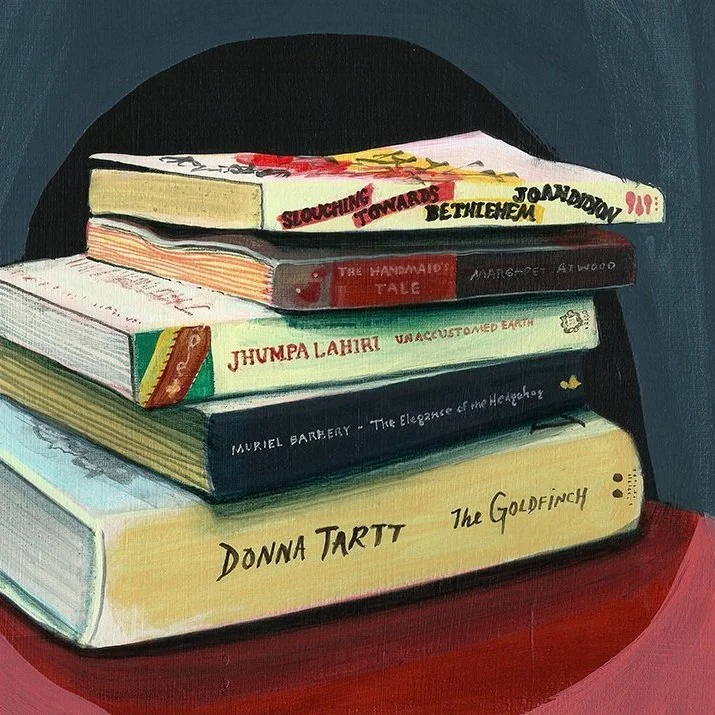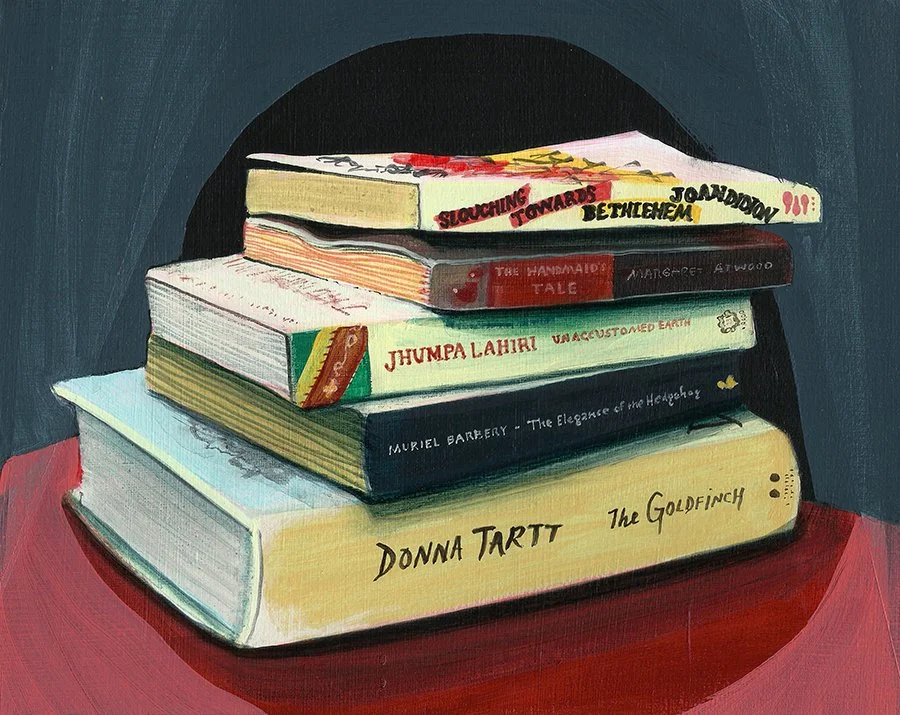Summer Reading List | Jordan Buschur
Summer Reading List | Jordan Buschur
Jordan Buschur, Stack 3, acrylic on paper, 8" x 10", 2022. Image courtesy of the artist.
Jacquelyn Gleisner: I found your work on Instagram. A friend had reposted an image of a commissioned painting shortly after Roe v. Wade had been overturned. You were raising money for WHO Ohio and the Center for Reproductive Rights by selling paintings from this series. Each painting features a curated stack of books, many by female authors. What was the motivation for beginning this series?
Jordan Buschur: Over the years I have donated my work to a variety of causes organized by others. When things seem particularly urgent, I have raised funds by selling directly through Instagram. In this case, when the Dobbs decision was leaked I felt that I needed to take action and put my labor towards raising funds to help provide abortion access. I’ve never opened up commissions in this way before, but it seemed like a beautiful way to raise money together and channel my anger into action, all while celebrating the contributions of women and non-binary writers and thinkers. Each painting is based on a photo of five or so books chosen by the person commissioning the work. It’s a reminder of our agency, and a powerful reading list. So far there are 16 commissions with $3,900 pledged. I have finished four; this work will take me into 2023.
Jordan Buschur, Changing Hands, acrylic on panel, 36" x 24", 2022. Image courtesy of the artist.
JG: You made the first painting of a stack of books shortly after you moved to a small town in Virginia. This painting marked an important shift away from the figure, and it also ignited what has remained an important theme in your practice as an artist. I’m interested in learning more about how you made this conceptual and formal leap in your paintings.
JB: At that time, I felt directionless with my work so I was making a lot of paintings searching for the subject matter. The figure kept getting smaller and smaller within the images, and eventually, it disappeared, which felt lonely. Simultaneously I was working on a bookbinding project, creating new books from old dust jackets. I had a stack of books from the local junk store on my desk for this purpose, but it just sang out to me to be a painting. There was finally a spark: the books could be a stand-in for the figure.
JG: Can you describe your process of selecting specific groupings of objects or books?
JB: I typically start a book painting by arranging a collection of books into stacks and then photographing them, which gives me control of the image from the very beginning. With other paintings, like the drawers, I take photographs of the objects as I find them. The images that later become paintings have a mix of visual interest and personal resonance since I am painting collections from friends and family. I’m following both formal and conceptual paths.
JG: In some paintings of the stacks of books, the titles and authors are obscured, and the ephemera from drawers favor abstractions over illustrations. On the other hand, some works are more illustrative and detailed. Some works invite a more ambiguous interpretation, while others favor a more concrete reading of the paintings. Can you talk about the difference between these two approaches in your work?
JB: If I could choose only one line to ride while painting, it would be that balance between ambiguity and clarity. I think about this both in terms of how the images are rendered (mostly pointing towards recognizability, with some important asides into abstraction) and the amount of meaning available to the viewer. Each image is layered and layered with stories and feelings that I know and can name, along with narratives I will never know from the people whose collections I paint, added to the interpretations and associations of those viewing the painting. Pinpointing exactly where the meaning might live is impossible, so the line between ambiguity and clarity is always blurred.
Jordan Bushur, Natural Knick-Knacks, acrylic on panel, 36" x 24", 2021. Image courtesy of the artist.
JG: Throughout your career, you’ve worked as a studio manager, gallery director, as well as in arts administration. You’re currently an educator. Building a life that complements one’s studio practice can be challenging. What strategies or experiences have helped you thrive as an artist?
JB: I feel lucky that I have been able to keep art at the forefront of my life. It has been fulfilling to be part of a community through a variety of arts-related jobs, and the reality is that it has always been necessary for me to have a job in order to sustain my studio practice. I like doing both. Currently, I spend the majority of my time as a caregiver to my three young children. I also teach one class per semester at the University of Toledo and paint as often as I can. My schedule is somewhat set, but shifts based on the needs of those three parts. Flexibility is essential, though it is not always comfortable. If I can keep that mindset, I’m much happier.
JG: Are there any books you’d like to recommend?
JB: I just finished The Need by Helen Phillips which is a story of motherhood felt deep in the body, with some heavy otherworldly twists. I couldn’t put it down. I love reading Louise Erdrich, I think I started with Love Medicine and The Beet Queen back in my early 20s. I’m pacing myself moving through her catalog, savoring it.
Jordan Buschur, Compass, acrylic on panel, 40" x 30", 2020. Image courtesy of the artist.
Jordan Buschur
Jordan Buschur is an artist, educator, and curator based in Toledo, Ohio. Her paintings focus on collections of objects ranging from stacked books to interiors of drawers, all united by a system of value based on mystery, sentimentality, and a matriarchal connection. Buschur received an M.F.A. in Painting from Brooklyn College, the City University of New York. Her work has been shown in numerous locations, including exhibitions with the Urban Institute for Contemporary Arts (Grand Rapids, MI), Center for Book Arts (NY), and Field Projects (NY). She participated in residencies at the Wassaic Project, Chashama North, the Kimmel Harding Nelson Center for the Arts, and the Vermont Studio Center. Awards include the Ohio Arts Council Individual Excellence Award, the Kimmel Foundation Artist Award, and the Charles Shaw Painting Award. She is a co-founder of Co-Worker Gallery and has curated exhibitions at Cuchifritos Gallery (NY), Spring/Break Art Show (NY), and the Neon Heater (Findlay, OH). Buschur was the Director of the Eisentrager-Howard Gallery at the University of Nebraska, Lincoln, and currently teaches at the University of Toledo. Follow her on Instagram: @jordanbuschur.







